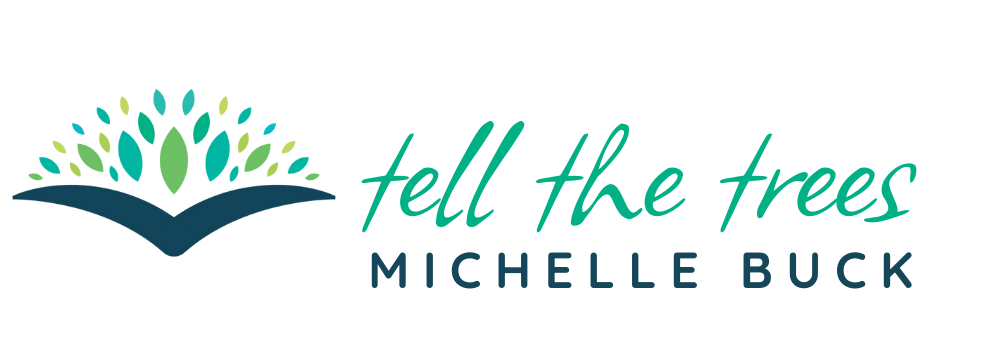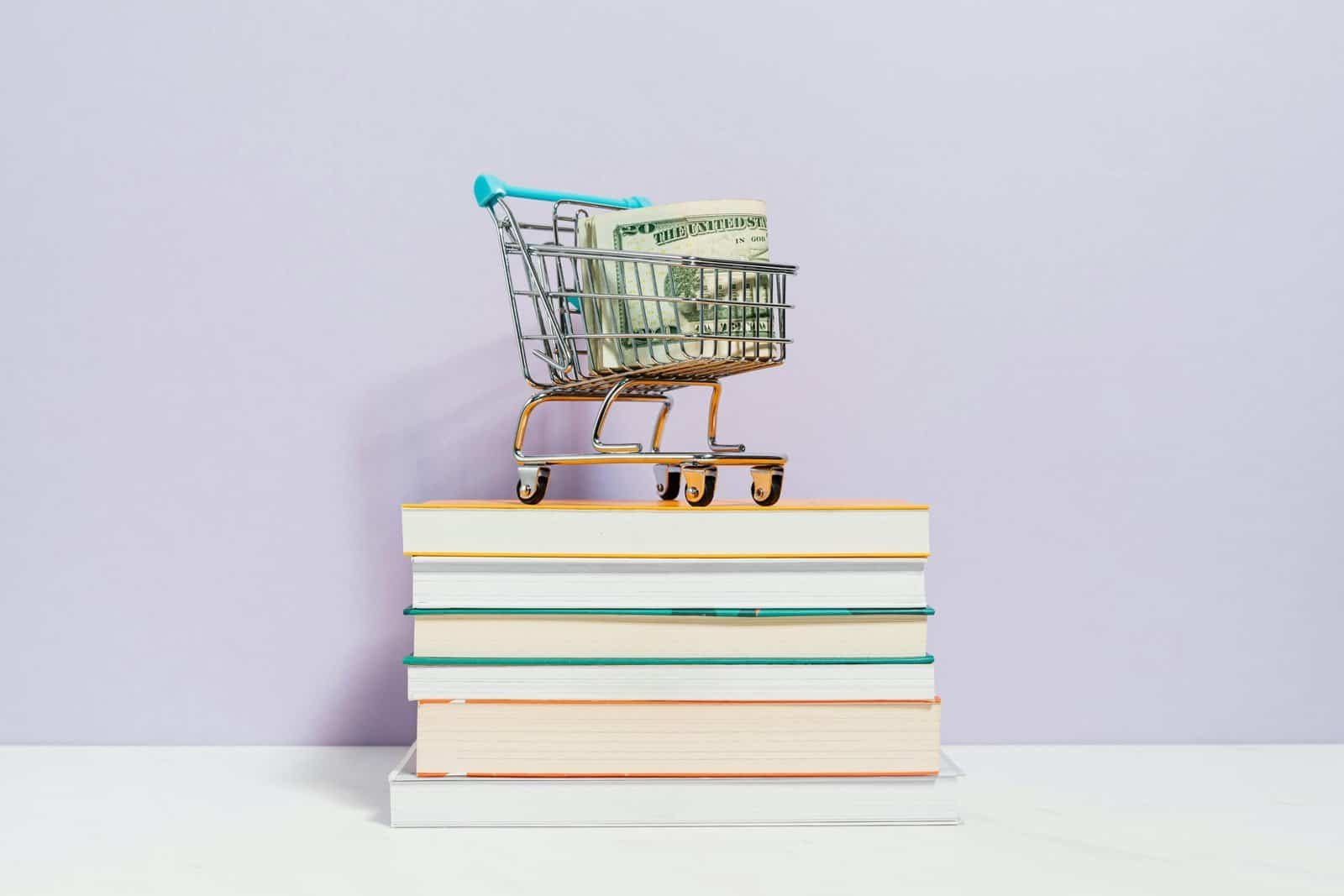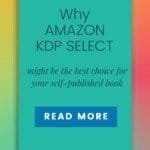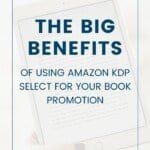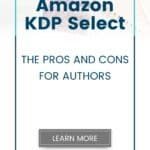by Michelle
Share
by Michelle
Share

If you are new to self-publishing, Amazon KDP Select might be the best choice for your new book. With opportunities to reach more readers through Amazon and Kindle promotions, your book can benefit from Amazon’s resources.
But the catch?
Your ebook must be exclusive to Amazon during this period (you commit to 90 days of enrollment).
What Exactly is Amazon KDP Select?
KDP Select is Amazon’s free 90-day program specifically for Kindle ebooks. It gives you the opportunity to reach more readers as Amazon has around a 70% market share (meaning they are at the top for self-publishing book sales). When you enroll, you can also be a part of Kindle Unlimited, which is a reader membership program where you can earn per page read. But the biggest drawback is you cannot list your ebook anywhere else.
The Big Benefits
Let’s look at the major benefits in more detail.
1. Kindle Unlimited Exposure and Earnings
When your book is in KDP Select, readers can discover it through Kindle Unlimited in multiple countries including the U.S., U.K., Germany, Italy, Spain, France, Brazil, Mexico, Canada, India, Japan, and Australia.
Instead of earning royalties on sales, you earn based on pages read by KU subscribers. For non-fiction authors with valuable, information-packed content, this can be a hidden income stream. (Note: personally, I see most of my sales from print books. KU doesn’t bring me a ton of sales. This might be different for you though.)
2. Promotional Tools on Amazon KDP Select
As a Select author, you can use Amazon’s Promotions dashboard to create a Kindle Countdown Deal for books priced at $2.99 or above. This lets you discount your book while still maintaining the 70% royalty rate—even if your price drops to $0.99 temporarily. You can also run free book promotions for up to 5 days per 90-day enrollment period.
I recently ran a 5 day free book promotion and saw an increase in sales. However, I ran the promotion alongside a paid promotion (Freebooksy) and I believe that helped boost my book downloads. A good strategy for using the promotions on Amazon is to run it with another promotion. You can check out some free sites to list your book here.
3. Higher International Royalties
Enrolling in Amazon KDP Select gives you a nice advantage—you’ll earn 70% royalties in international marketplaces including India, Brazil, Japan, and Mexico. Authors who don’t enroll only have the 35% royalty option available in these territories. I’ll talk more about how this compares to publishing wide, as other platforms also offer the 70% royalties, but Amazon earning will decrease to 35% if you choose to use another platform.
4. Potential for KDP All-Star Bonuses
If your book really takes off, there’s another perk: Authors who are successful with page reads can earn KDP All-Star Bonuses. These rewards go to authors who rank in the top 100 in the paid Kindle store.
Why Amazon KDP Select Might Be Perfect for Non-Fiction Authors
Sometimes a reader doesn’t want to invest in buying a book. Think about those people that like to use libraries or are avid readers, but don’t enjoy filling their shelves with books. They might be more willing to borrow a book from KU to get the information they need. (Fun Fact: When I write books, I am often using Kindle Unlimited to read books so I don’t have to purchase an arsenal of books just to research a topic.)
If your book offers value to the reader, think of the non-monetary earnings that could bring you. Maybe it’s an email sign up, a follow on Substack, or even a purchase on your website. I believe books can gain authors momentum even if the earnings aren’t as great as we’d like. We can see the benefits in other ways.

The Big Trade-Off
Obviously, the disadvantage to using Amazon KDP Select is that you can’t offer your book on other platforms, not even your own website. If you want your book to be available to other retailers or even the library, or in countries that Amazon Kindle doesn’t have a store, you might want to consider going wide instead.
Even if you list your books on Amazon, you’ll still need to find ways to promote your books. Your enrollment in KDP Select will automatically renew every 90 days unless you uncheck the auto-renew box before the renewal date.
One strategy is to list your ebook on Amazon for 90 days and then switch to enrolling it elsewhere. You can always test it out and see what platforms get you the most benefits.
A Note About Royalty Rates
Amazon KDP (outside of Select) offers royalties ranging from 35% to 70%, depending on your book pricing and whether you’re in their exclusivity program. For books priced between $2.99 and $9.99, you can earn 70% royalties, but below $2.99 or above $9.99, you’ll typically receive 35%.
Kobo Writing Life emphasizes international reach and offers up to 70% royalties on eBooks priced over $2.99. They’re particularly strong in Canada and international markets where Amazon isn’t as dominant.
Apple Books typically offers a straightforward 70% royalty rate regardless of price point, which is one advantage of publishing directly with them.
Barnes & Noble Press offers similar royalty structures to Amazon, with 70% for books in the optimal price range and 35% for others.
Using Aggregators (Distribution Services)
If you use an aggregator like Draft2Digital to distribute to multiple platforms:
Draft2Digital (D2D) takes a 10% commission regardless of which store your book sells through. This means if a retailer pays 70% royalty, you’ll get about 60% after D2D takes their cut.
Print Book Royalties When Going Wide
For paperbacks, the royalty structure is different:
With Draft2Digital’s print service (D2D Print), you can expect to make about 45% of the list price minus the printing cost.
The recommendations I’ve heard is to go with Ingram Spark for print instead of D2D. But I’ve not tested that theory out.
Considerations for Going Wide
The main thing to remember when going wide is that while you might earn higher royalties on some platforms compared to KDP Select, you’re trading Amazon’s exclusivity bonuses (like Kindle Unlimited page reads) for broader distribution. Many authors find that having books available on multiple platforms provides more stability long-term, even if individual book earnings might be somewhat lower initially.
Is Amazon KDP Select Right For YOUR Book?
The answer depends on your specific goals, genre, and audience.
Ask yourself:
- Does your target audience primarily shop on Amazon, or are they scattered across different platforms?
- Do bestsellers in your non-fiction niche include many Kindle Unlimited titles? (This suggests readers in your space are KU subscribers)
- Would you benefit more from concentrated marketing efforts on one platform versus spreading yourself thin across many?
- Is this your first book, where Amazon’s larger audience might help you gain initial traction?
For my first few books, I used Amazon exclusively, but now I’m going to try my hand at “going wide” and see what happens. Even if you have older books on Amazon, you can opt out of KDP Select and try it on other platforms.
In the next part of this series, we’ll explore the wide distribution strategy. If you have questions, you’d like me to address, please let me know.
Here’s what you can expect:
- Part 1: Amazon KDP Select: Is Exclusivity a Surprisingly Good Offer?
- Part 2: The Amazon KDP Select Advantage (you are here)
- Part 3: The Remarkable Amazon KDP Alternative You Need to Know
- Part 4: Draft2Digital Deep Dive
- Part 5: Financial Considerations
- Part 6: Making Your Decision
- Part 7: Implementation Plan
- Conclusion
Tell the Trees is supported by its readers. When you make a purchase using links on this site, it may result in affiliate commission. Please visit my affiliate disclosure page for more information.
Let's Discuss It
The EU Accessibility Act officially kicked in on June 28, 2025, and that means it's being enforced right now. Here's what to expect for self-publishing.
Sometimes what we call perfectionism is just fear of rejection in disguise. We keep our work hidden because putting it out there means people can judge it.
Ever wonder why some books take off with book sales while others collect digital dust? When it comes to book marketing, I’ve noticed the same problems pop up again and again. Let me walk you through a real example that perfectly illustrates what NOT to do—and more importantly, how to fix it. The Post &
D2D for print books will not replace Amazon KDP for most authors—the royalty difference is just too significant if you're primarily selling direct to consumers online. But it's not supposed to replace Amazon; it's supposed to complement it.
